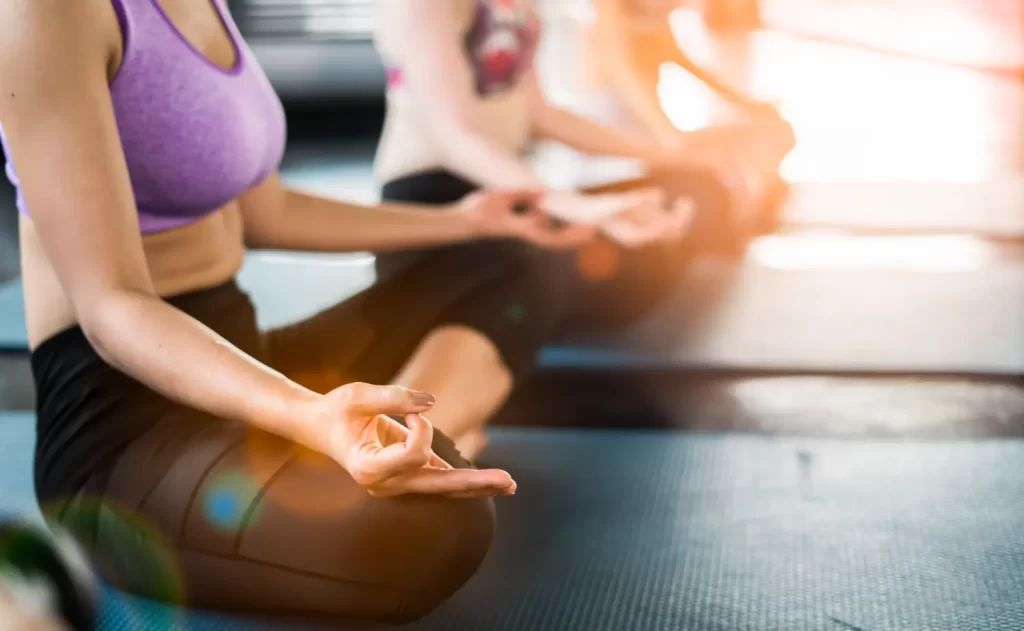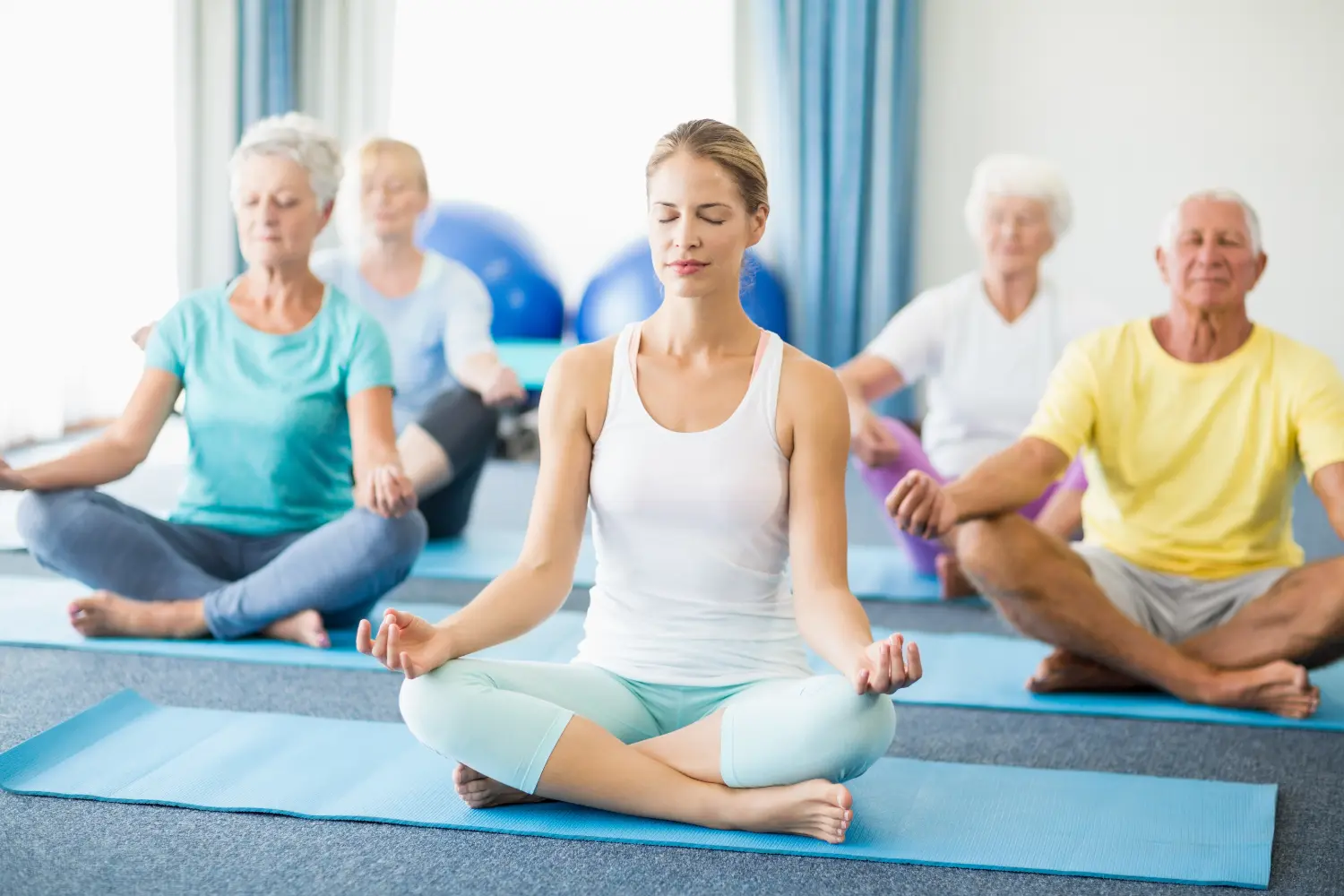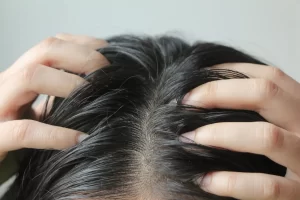Yoga Poses for Menopause: Improve Sleep, Reduce Stress, and More

Menopause brings significant changes to the body, often affecting sleep, stress levels, and overall well-being. While it’s a natural phase of life, its symptoms—like insomnia, anxiety, hot flashes, and joint stiffness—can be challenging to manage.
Yoga is a powerful tool for navigating menopause, offering relief through gentle movement, deep breathing, and relaxation techniques. Studies suggest that yoga can improve sleep, reduce stress, and support hormone balance, making it a holistic approach to menopause wellness.
How Yoga Supports Menopause Symptoms
Menopause is a natural transition, but it can bring uncomfortable symptoms. Practicing yoga for menopause offers a holistic way to manage these symptoms by supporting both physical and mental health. Here’s how:
Regulates Hormones
Certain yoga postures and breathing techniques help balance the endocrine system, which plays a key role in hormone regulation. This can lead to fewer mood swings and more emotional stability.
Reduces Stress & Anxiety
Menopause can heighten stress responses, leading to irritability and anxiety. Yoga activates the parasympathetic nervous system (the body’s “rest and digest” mode), lowering cortisol levels and promoting relaxation.
Improves Sleep Quality
Insomnia is a common issue during menopause. Yoga encourages deep breathing and gentle movement, helping to calm the nervous system and prepare the body for restful sleep.
Supports Joint & Bone Health
The drop in estrogen during menopause can weaken bones. Weight-bearing yoga poses help maintain bone density, while stretching increases flexibility and reduces stiffness.
By incorporating yoga into your routine, you can ease menopause symptoms naturally while improving overall well-being.
Best Yoga Poses for Menopause
Incorporating yoga for menopause into your routine can help alleviate common symptoms like stress, insomnia, and joint stiffness. The following poses focus on relaxation, hormone balance, and overall strength, making them ideal for menopausal women.
Poses for Better Sleep
- Legs-Up-The-Wall (Viparita Karani) – This gentle inversion helps calm the nervous system, reduces swelling in the legs, and promotes deep relaxation before bedtime.
- Reclining Bound Angle (Supta Baddha Konasana) – A restorative pose that opens the hips and chest, releasing tension and encouraging restful sleep.
Poses for Stress Relief
- Child’s Pose (Balasana) – A grounding posture that soothes the nervous system, stretches the lower back, and promotes deep breathing to reduce anxiety.
- Cat-Cow Stretch (Marjaryasana-Bitilasana) – A flowing movement that increases spinal flexibility, improves circulation, and relieves stress stored in the back and shoulders.
Poses for Hot Flashes & Mood Swings
- Bridge Pose (Setu Bandhasana) – A gentle backbend that stimulates the thyroid gland, helping regulate hormones and balance emotions.
- Seated Forward Bend (Paschimottanasana) – This forward fold calms the mind, relieves headaches, and cools the body, making it great for hot flashes.
Poses for Bone Health & Strength
- Warrior II (Virabhadrasana II) – A strength-building pose that improves bone density, enhances balance, and increases stamina.
- Tree Pose (Vrksasana) – A balancing pose that strengthens the legs and core while improving focus and stability.
By practicing these poses regularly, you can manage menopause symptoms naturally while improving flexibility, strength, and mental clarity.

A Simple Yoga Routine for Menopause
To experience the full benefits of yoga for menopause, consistency is key. Below is a simple, 15-minute yoga routine designed to ease symptoms like stress, sleep disturbances, and joint stiffness. This routine can be practiced in the morning for energy or in the evening for relaxation.
Step-by-Step Yoga Flow
- Seated Breathing (Pranayama) – 2 minutes
- Sit comfortably with a straight spine.
- Close your eyes and take deep, slow breaths in through your nose and out through your mouth.
- Focus on extending your exhales to calm the nervous system and reduce stress.
- Cat-Cow Stretch (Marjaryasana-Bitilasana) – 1 minute
- Begin on all fours with hands under shoulders and knees under hips.
- Inhale, arch your back, and lift your chest (Cow Pose).
- Exhale, round your spine, and tuck your chin (Cat Pose).
- Flow between these movements to improve spinal flexibility and relieve tension.
- Child’s Pose (Balasana) – 2 minutes
- Sit back on your heels and stretch your arms forward, lowering your forehead to the mat.
- Relax your shoulders and take deep breaths to release stress.
- Legs-Up-The-Wall (Viparita Karani) – 3 minutes
- Sit next to a wall and swing your legs up while lying on your back.
- Rest your arms at your sides and focus on slow breathing.
- This pose helps with circulation, reduces swelling, and prepares the body for sleep.
- Reclining Bound Angle (Supta Baddha Konasana) – 3 minutes
- Lie on your back with the soles of your feet together, letting your knees drop open.
- Place one hand on your heart and one on your belly.
- Close your eyes and breathe deeply, allowing your body to relax.
- Savasana (Final Relaxation) – 4 minutes
- Lie flat on your back with arms by your sides, palms facing up.
- Allow your entire body to soften and release tension.
- Focus on your breath, letting go of stress and tension.
How to Get the Most Out of This Routine
- Practice daily for long-term relief from menopause symptoms.
- Modify poses as needed to accommodate your flexibility and comfort level.
- Use props like yoga blocks or a bolster for additional support.
This gentle sequence promotes relaxation, reduces stress, and improves sleep quality, making menopause a more balanced and manageable experience.
Additional Lifestyle Tips for Managing Menopause Naturally
While yoga for menopause is a powerful tool for easing symptoms, combining it with other healthy lifestyle habits can enhance its benefits. Here are some additional strategies to support your body and mind during menopause.
Prioritize Hydration and Nutrition
- Drink plenty of water to stay hydrated and help regulate body temperature, especially if you experience hot flashes.
- Eat calcium and vitamin D-rich foods like leafy greens, almonds, and dairy (or plant-based alternatives) to support bone health.
- Include phytoestrogen-rich foods such as flaxseeds, soy, and chickpeas to help balance hormones naturally.
Practice Mindfulness and Meditation
- Meditation reduces stress and promotes emotional balance, making it an excellent complement to yoga.
- Even 5-10 minutes of daily mindfulness can help you feel more centered and resilient.
- Try guided meditations or breathing exercises to calm the mind and improve focus.
Establish a Relaxing Bedtime Routine
- Create a consistent sleep schedule by going to bed and waking up at the same time daily.
- Avoid caffeine and screen time before bed, as they can disrupt sleep.
- Practice Legs-Up-The-Wall pose or deep breathing before bedtime to signal relaxation to your body.
Stay Active Beyond Yoga
- Engage in weight-bearing exercises like walking, light strength training, or Pilates to support muscle and bone health.
- Regular movement reduces stiffness, improves circulation, and enhances overall well-being.
Seek Support and Community
- Connect with others going through menopause—support groups, wellness communities, or even yoga classes tailored for menopause can be helpful.
- Don’t hesitate to seek guidance from healthcare providers for additional support, especially if symptoms are severe.
By combining yoga with these simple lifestyle habits, you can create a holistic approach to managing menopause naturally, feeling more balanced and in control of your body.
Conclusion
Menopause can bring challenges, but with the right tools, it can also be a time of empowerment and renewal. Yoga for menopause offers a natural way to ease symptoms, improve sleep, reduce stress, and support overall well-being.
Key Takeways:
- The best yoga poses to manage menopause symptoms, from stress relief to bone health.
- How yoga promotes hormonal balance, relaxation, and improved sleep.
- A simple, effective yoga routine tailored for menopausal women.
By incorporating yoga into your daily routine and complementing it with healthy lifestyle habits, you can navigate menopause with greater ease and confidence. Ready to take the next step? Explore more wellness resources on CellaMD and start your journey to a balanced, healthier menopause today!
 By Dina Anderson
By Dina Anderson June 19, 2025
June 19, 2025














